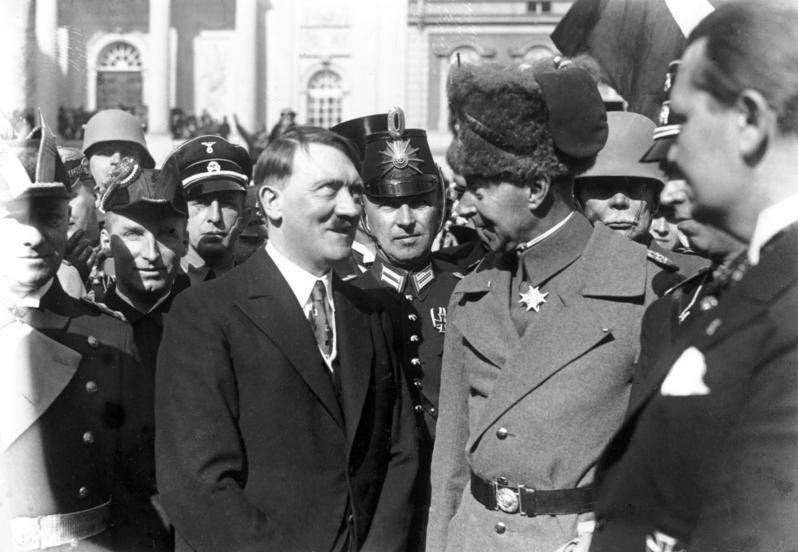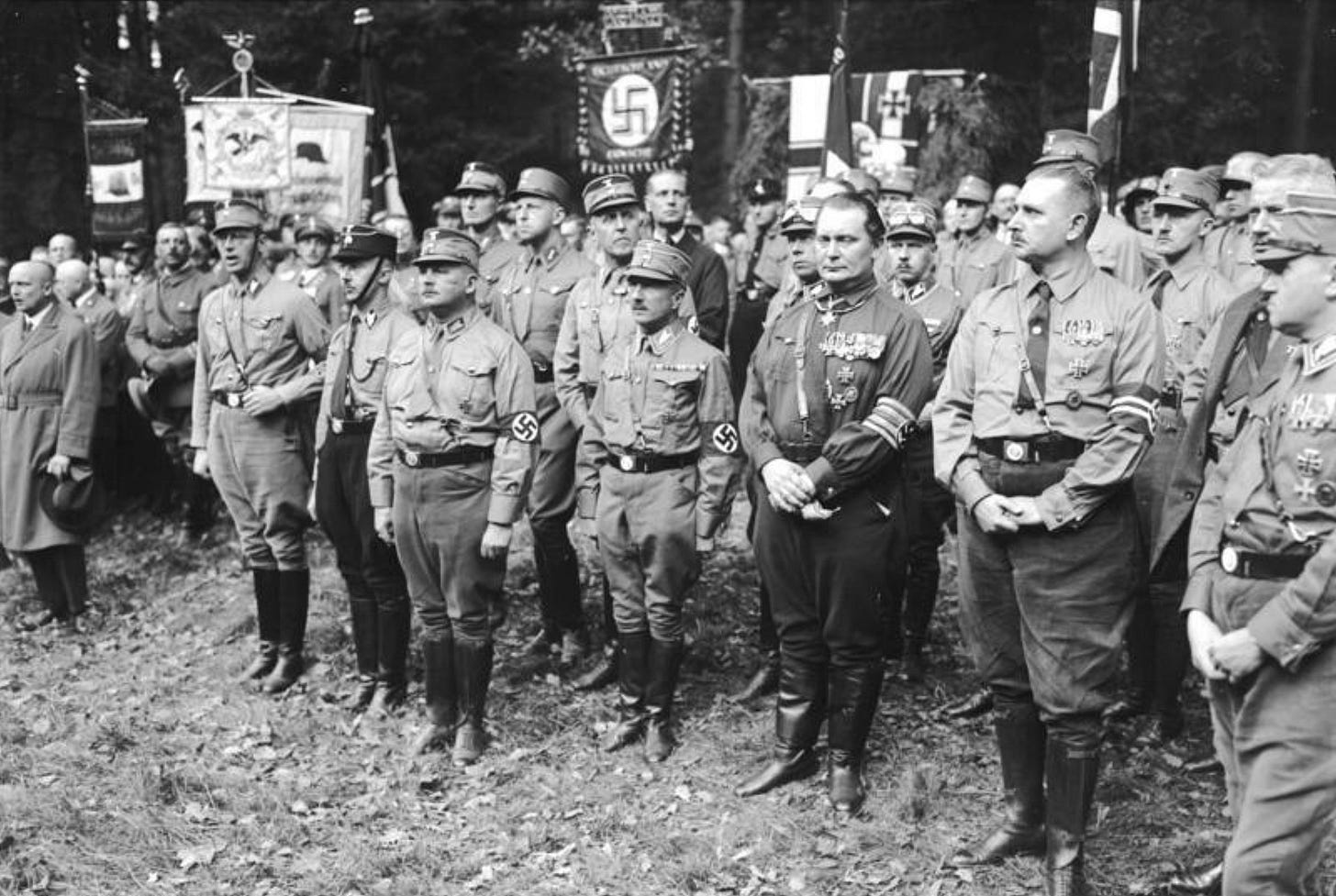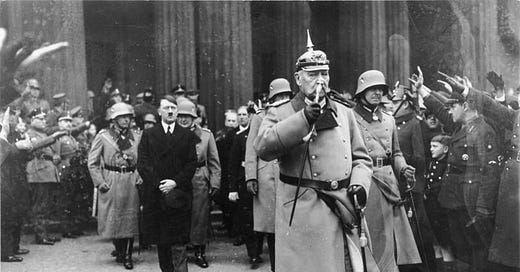United Right, Divided Left: The Rise of Nazi Dictatorship
A historical analysis essay (April 2022) for a Sophomore Year UVM History Class on Modern German History
This is a story of how left-wing infighting, and contrasting political unity amongst the political right led to Adolf Hitler successfully constructing the most criminal totalitarian regime in history.
Adolf Hitler was appointed Chancellor of Germany in early 1933, at the head of a government that was neither stable nor even genuinely in control of the German state. By mid-1934, Hitler and the NSDAP (Nationalsozialistische Deutsche Arbeiterpartei – National Socialist German Workers’ Party, hereafter referred to as the Nazis) had set up a totalitarian dictatorship and asserted supremacy over the entire German political scene. This was made possible by the willing enthusiasm of the conservative elite to cooperate with Hitler and the Nazis. This alliance of the National Socialists and the traditional right-wing elite, and the simultaneous disunity between republican and leftist political forces gave rise to the circumstances which the Nazis ruthlessly took advantage of to cement their control over the German state and set up their murderous dictatorial regime.
Following the elections of 1930, the inability of any chancellor to consolidate support in the hopelessly divided Reichstag led to a prolonged period of rule by decree. Chancellor Brüning’s austerity measures to address the Great Depression had given him the moniker the “Hunger Chancellor” as many languished without work or bread. Brüning's rule-by-decree (through Article 48 of the Weimar Constitution) terribly weakened parliamentary democracy’s institutions, and his economic policies further undermined public belief in the strength of democracy. (Orlow, 2018) There was rampant unemployment, lawlessness, and social malaise. The paralysis of democracy and the atrocious economic conditions were fertile ground for the Nazis’ aggressively nationalistic chauvinistic, anti-parliamentary, antisemitic message, and the Nazis gained ground in elections at the federal and state level. (Orlow, 2018)

At the same time, forces of the conservative "Old Guard,” - military officers, right-wing bureaucrats and judges, the Junker class, national-conservative politicians, and traditional elites-were working diligently to bring down the Republic and bring about authoritarian dictatorship and monarchical restoration. This elite despised parties, parliamentarianism, liberalism, and socialism and eagerly sought the restoration of autocracy and military rule. Brüning's successor as Chancellor, Franz von Papen, an avowed reactionary monarchist, was very conciliatory towards the Nazis who he viewed as a natural partner for the right-wing forces. He lifted the ban on the SA (the Nazi armed wing) that had been implemented by SPD Minister Carl Severing. (Orlow, 2018) Furthermore von Papen made institutional changes which eased the Nazi path to power. In the 1932 Preußenschlag, von Papen removed the SPD government of the Free State of Prussia and implemented direct rule centralized in the hands of the political right. This move was transparently meant as a step towards the construction of a right-wing authoritarian regime that would replace the Weimar system. By removing Otto Braun’s SPD government, a powerful opponent was sidelined to the construction of dictatorship. Von Papen and the traditional right viewed the Nazis as allies, in a joint mission to destroy Weimar and the left. The Old Right showed a desire to cooperate with Hitler and even did some of Hitler’s work for him in constructing a dictatorship. (Orlow, 2018)

Neither the Nazis (despite being the largest single party) nor the parties of the traditional right could alone or together command a majority of the Reichstag in 1932. They therefore had to cooperate to increase their joint institutional power. In some respects, the Nazis and the traditional right were not naturally predisposed to one another. There were personality clashes involving Hitler and President Hindenburg and others, and concern from elites on the anti-establishment rhetoric of some prominent Nazis such as Ernst Röhm and Gregor Strasser. (Orlow, 2018) However, the Nazis and the traditional right did share numerous mutual aims. Hitler and his counterparts were both fanatically determined to violently eliminate the left, dismantle Weimar democracy, and repudiate the Versailles Treaty. (Orlow, 2018) They could very well work together on that basis. Hitler’s appointment as Chancellor by President Hindenburg (himself a member of the conservative elite milieu) in early 1933 was the result of such dealmaking. Hitler showed patience and intelligence in these negotiations by only joining the government as its head, and not as Vice-Chancellor, showing a determination not to be made a junior partner as the traditional right intended.
The traditional right did not support a Nazi totalitarian regime, far from it, they imagined themselves as senior partners to the Nazis in authoritarian monarchy. (Orlow, 2018) They did not smile upon the gradual dissolution of their political vehicles (such as the Deutschnationale Volkspartei or DNVP) or their later exclusion from power. However, they and the Nazis both shared a vision of a new right-wing nationalist state, a state that would throw off the limitations of the Versailles Treaty and destroy the left, parliamentarianism, and trade unionism. (Orlow, 2018)
Though they imagined Hitler as a junior partner, Hitler refused to accept the role of a sidekick. With consistently strong showings in elections and a devoted following, he demanded the leadership role. When he acquired the Chancellorship, he further undermined efforts to subvert his power but taking key Ministries for the Nazi Party while ostensibly only taking a few. At the same time he showed deference to the traditional elite, such as at the Day of Potsdam ceremonies to open the new Reichstag where he portrayed himself as a servant to Hindenburg. Meanwhile, he used the shared goals he had with the traditional right, destroying the Republic and smashing the left, that animated them so much that they were willing to give Adolf Hitler dictatorial powers to do so. Powers that Hitler used very effectively to consolidate power and sideline the old right.

The Reichstag Fire of early 1933 provided Hitler the perfect opportunity to use his allies' fear of and hatred for the communists to concentrate power in the chancellorship and the Nazis, in time effectively sidelining the "Old Guard” of the right. The Reichstag Fire Degree, signed by the President, suspended civil liberties and gave way for effectively banning the KPD. Hitler had called for early elections as soon as he assumed the office of Chancellor, which took place only six days after the fire. During the campaign, Hitler had flagrantly used state power against anti-Nazi parties. He not only shut down opposition party newspapers and drove the KPD underground after the fire, but he let the SA behave as they liked, harassing and beating campaigners for the Social Democrats, Center Party, and Communists. The Nazis and the DNVP together won a majority of seats. The election was neither free or fair, but it neutered effective parliamentary opposition to Hitler.
In the new Reichstag, Hitler sought to go further than the temporary Fire Decrees. He proposed the Enabling Act, which would establish a constitutional dictatorship and allow the Chancellor to govern without the Reichstag and ban the defiant Social Democrats. In their drive to eradicate the left and dismantle parliamentary rule, the DNVP supported it. But the Enabling Act, being a constitutional amendment, needed a supermajority of votes. In order to pass the Enabling Act, Hitler needed the support of the Deutsche Zentrumspartei better known simply as the Center Party.
The Center Party had been the political party for Germany’s sizable Catholic minority since 1870. It was strongest in the Rhineland and the south of Germany, where Catholics were populous. The Center had been key to the pro-democracy “Weimar Coalition” that had propped up liberal governments in Germany since the beginning of the Republic. It also had a pool of reliable voters, despite the rise of extremism, it consistently won 10-15% of the vote without fail. But the Center Party was fractious, with a right and left wing. Franz von Papen had been on the right-wing of the party, before leaving due to his opposition to parliamentary democracy. The leader of the party after 1928 was Ludwig Kaas, a Catholic priest from the Rhineland. Kaas viewed Marxism as the biggest threat to Catholicism in Germany, not the Nazis (Orlow, 2018), and believed that perhaps an authoritarian regime was needed to protect the Church.

Kaas remained fearful of the Nazis however, and was reluctant to support an act that would make Hitler a dictator. It took concessions from Hitler on the rights of Germany’s Catholics, and the promise of a Reichskonkordat (which was negotiated that summer and repeatedly violated by the Nazis after) negotiated between the German government and the Holy See to secure Kaas’s support. Kaas also worried for the future of the party if they opposed the act, in the face of SA and state violence. Therefore, Kaas instructed his party to vote for the proposal. Hitler filled the Reichstag chamber with SA brutes, and the Enabling Act was passed. The Center Party and its reliable supporters could have stood at as a base for anti-Nazi forces to rally around, but instead it acquiesced.
Within a few short months, non-Nazi parties, including the Center, the SPD, and even the DNVP were banned or dissolved themselves. German federalism was abolished, the self-governing states being reformed into new administrative districts controlled by Berlin. (Orlow, 2018) Jews were expelled from the civil service, with more antisemitic laws in development. The political and social vehicles of the working class, the independent trade unions, were banned. The first concentration camps to hold political enemies were also constructed. The Weimar Republic was finally, indisputably dead.
In the past the left had successfully blocked the right’s attempt to seize power dictatorially. A united left-wing front led by the SPD had successfully blocked an attempted right-wing seizure of power in the 1920 Kapp Putsch with a general strike. A similar action in 1933 could have frustrated the designs of Hitler and his allies. But there was no united left-wing to speak of. The animosity between the two parties of the left, the SPD and KPD, was intense. The KPD reviled the SPD as “social fascists,” no better than the Nazis, who had sanctioned the slaughter of the Spartacists by the reactionary Freikorps in 1919 and betrayed revolutionary class politics for reformist collaborationism. On the other hand, the SPD were terrified of the KPD, whose comrades in Russia had massacred the moderate socialists upon assuming power in 1917 and established the nightmarish Stalinist dictatorship. Yet despite this, in 1920 the KPD had joined the SPD to stop the Kapp Putsch. In 1933, they did not move to work with the SPD.
Not only did the KPD regard the SPD as an enemy, but under the Moscow doctrine of “social fascism” they deemed that the SPD was in fact the greatest enemy of the German communists, and the “real vanguard” of fascism and capitalism. (Orlow, 2018) Furthermore they opposed Weimar democracy in favor of Leninist “dictatorship of the proletariat” and did not see merit in working hard to defend parliamentary democracy. As a result, KPD efforts were devoted to weakening the SPD, even though the SPD was the strongest obstacle to the very real, very dangerous fascists, the Nazis. (Orlow, 2018) Furthermore, the violent rhetoric of the KPD urging an immediate proletarian revolution only terrified the middle classes, who looked to the Nazis for salvation from the hated Bolsheviks. (Orlow, 2018) The disunity and conflict on the left benefitted Hitler and the right most of all, who did not have to deal with a unified working-class opposition. While the left was divided and in conflict with each other, the right was in lockstep, dead set on the destruction of their enemies.

With the imposition of the single-party dictatorship by Hitler, the only remaining bastions of conservative power remained in the Reichswehr (the army) and President Hindenburg, either of whom could remove the Chancellor. These bastions favored a restored monarchy backed up by the military, not a Hitler totalitarian regime. The military remained the most powerful single force in Germany, not the Nazi Party. Military bluebloods strongly objected to the SA who they saw as uncivilized brutes, and more importantly a threat to the traditional power of the army, which went back to the 18th century Kingdom of Prussia. The chief of the SA, Ernst Röhm, held ambitions to replace the Reichswehr with the SA as responsible for Germany’s defense. Not only that, he fervently supported a “second revolution” against the establishment in the military and the economy, further terrifying the army leadership. Hitler recognized the peril of the situation, he knew the army could remove him and he needed the professional German soldiery for the wars to come. He acted deftly and with cleverness. On the Knight of the Long Knives, Hitler had Röhm and his leadership clique murdered along with several other old and potential future enemies. Subsequently, the SA was permanently sidelined. (Orlow, 2018)
As a result of these purges, Hitler placated the army and convinced them of their safe, privileged, and permanent role in Hitler’s Reich. (Orlow, 2018) Furthermore, by sidelining the SA, he secured full control of the Nazi Party, with the largest independent power bloc totally subordinated to him. With the death of President Hindenburg in August 1934, Hitler, with the support of the army and the conservative elite, merged the offices of Chancellor and President into the position of Führer, at last making himself the undisputed supreme master of Germany.

The irreplaceable key to the rise of Hitler from merely a freshly appointed weak Chancellor to supreme master of Germany was the willingness of the traditional right-wing to cooperate with and elevate the Nazi Party and Adolf Hitler. Not only did they dismantle institutions standing in Hitler’s way, but they eagerly gave him power to destroy shared enemies, regardless of how powerful it made Hitler. At the same time, the left was compromised by division and infighting which lead to the absence of real opposition to Hitler’s actions. It was the feverish urge to work with Hitler to destroy Weimar on the part of the traditional right and the disunity of the left, which was crucial to the rise of Adolf Hitler and the domination of the Nazi Party over Germany that calcified by 1934.
Citations
Orlow, Dietrich. A History of Modern Germany. 8th ed. 2018. Reprint, Taylor and Francis, 2018. https://www.perlego.com/book/1522619/a-history-of-modern-germany-1871-to-present-pdf.
All Images Wikimedia Commons




